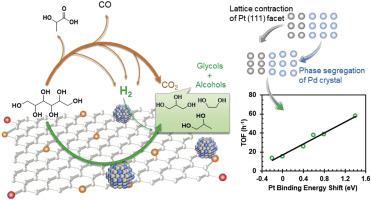Materials Today Sustainability ( IF 7.8 ) Pub Date : 2020-07-08 , DOI: 10.1016/j.mtsust.2020.100047 X. Jin , W. Zhang , D. Zhang , B. Yin , X. Liu , G. Zhang , H. Yan , M. Liu , C. Yang , B. Subramaniam , R.V. Chaudhari

|
Catalytic transfer hydrogenolysis (HDO) of polyols by in situ formed H2 under mild reaction conditions and displays both technological and environmental advantages over conventional HDO processes operating at elevated temperatures and pressures. Current studies on catalyst design are primarily focused on compositional features of solid catalysts to obtain superior activity and selectivity to value-added products. A major challenge is to understand the electronic nature of catalysts in C–H, C–C, and C–O cleavage of polyols. In this work, we report a design principle for modulating lattice and electronic configuration of bimetallic PtPd-N-doped mesoporous carbon (NMC) catalysts, immobilized on N-doped carbon, for highly efficient transfer HDO of sorbitol to renewable glycols and alcohols in base-free medium. The finding is that lattice strain and electronic coupling at metal-N interface induce confined growth of PtPd crystal facets, leading to strained structures with Pt lattice contraction and Pd phase segregation. While conventional PtPd nanoparticles exhibit monofunctional nature in facilitating C–H cleavage of sorbitol with poor activity, such unique PtPd-NMC catalysts display a synergistic fourfold activity enhancement (Turnover frequency (TOF): 58 h−1 at 200 °C) for tandem C–H, C–C, and C–O cleavage of polyols. Chemisoprtion and X-ray photoelectron spectroscopy spectroscopy studies reveal that N-doped carbon functions as a Lewis base and lattice modulator to manipulate electronic properties of bimetallic nanocatalysts for facile tandem C–H (H2 generation) and C–O/C–C cleavage (HDO) catalysis.
中文翻译:

晶格应变双金属PtPd纳米催化剂在无碱介质中显示山梨糖醇转移氢解的多功能性质
原位形成的H 2对多元醇的催化转移氢解(HDO)在温和的反应条件下,与在高温和高压下运行的传统HDO工艺相比,显示出技术和环境优势。当前对催化剂设计的研究主要集中在固体催化剂的组成特征上,以获得优异的活性和对增值产品的选择性。一个主要的挑战是要了解多元醇的CH,CC和OC裂解中催化剂的电子性质。在这项工作中,我们报告了一种设计原理,用于调节固定在N掺杂碳上的双金属PtPd-N掺杂中孔碳(NMC)催化剂的晶格和电子构型,以将山梨糖醇的HDO高效转移至碱中的可再生二醇和醇-无介质。发现是,晶格应变和金属-N界面的电子耦合引起PtPd晶面的有限生长,从而导致具有Pt晶格收缩和Pd相偏析的应变结构。传统的PtPd纳米粒子在促进山梨糖醇的C–H裂解时表现出单功能性,但活性较弱,但此类独特的PtPd-NMC催化剂显示出协同的四倍活性增强(周转频率(TOF):58小时) 多元醇的串联C–H,CC–和C–O裂解在200°C -1。化学同位素和X射线光电子能谱研究表明,掺N的碳起着路易斯碱和晶格调节剂的作用,可操纵双金属纳米催化剂的电子性质,以方便地串联C–H(H 2生成)和C–O / C–C裂解(HDO)催化。



























 京公网安备 11010802027423号
京公网安备 11010802027423号